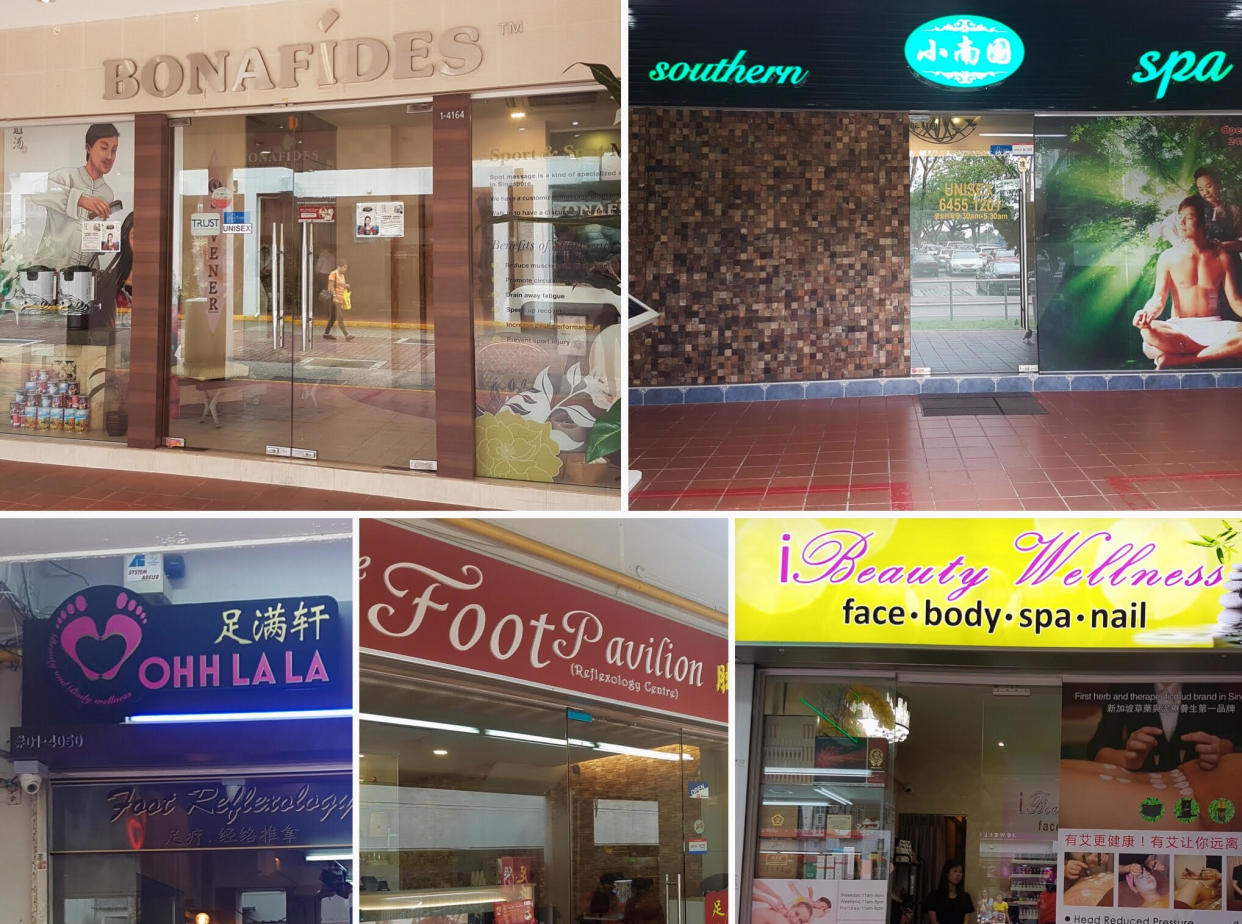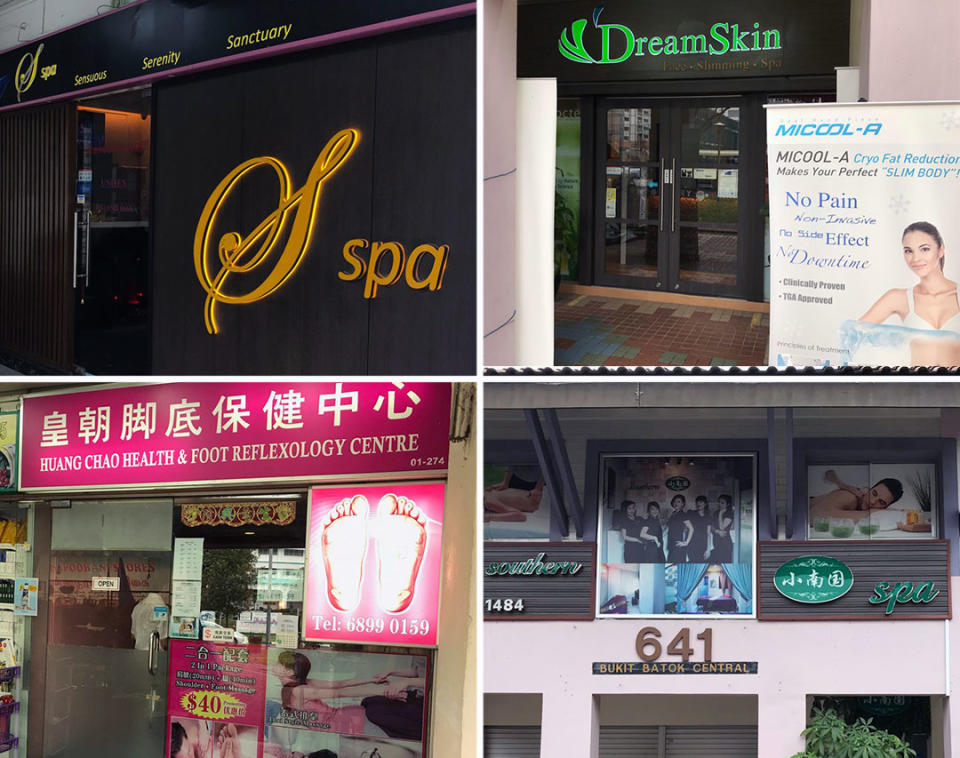Are heartland massage parlours rubbing residents the wrong way?

By Wan Ting Koh and Nigel Chin
Take a walk around the second floor of Boon Lay Shopping Centre and in less than a minute, you would find nine massage parlours along the same stretch.
Some offer traditional Thai massages while others advertise treatments that you would expect to see at hospitals, such as ovary and prostate care, rather than in the parlours’ dimly lit premises.
At the other end of the same floor is a FairPrice supermarket frequented by families with children. One shopper there, a 54-year-old insurance agent and father of two who only wanted to be known as Mr Lee, expressed disbelief when told of the number of massage parlours in the mall.
“I’m surprised that there are that many (massage parlours). I’ll be worried for my children if they were to walk past there… I don’t see a need to have so many parlours in this place,” he told Yahoo News Singapore.
Lee’s sentiment was echoed by 35-year-old Jackie Cheng, who runs a nearby mobile phone shop.
“I don’t understand why there are so many here… it’s not like this place has a lot of (human) traffic,” he said.
Over a few weeks in November, Yahoo News Singapore visited six heartland areas to observe the number of massage parlours there and the types of services they offered.
During a Parliamentary sitting on 4 November, several Members of Parliament (MPs) had raised their concerns about the high number of massage parlours in HDB estates. They were responding to efforts by the Ministry of Home Affairs (MHA) to clamp down on vice activities conducted in massage parlours, which include proposed amendments to the Massage Establishments Bill.
Foo Mee Har, MP for West Coast GRC, where the aforementioned shopping centre is located, said that “the proliferation of massage outlets in our HDB and residential estates is of significant concern for many residents”.
Residents are worried that “such outlets can be used as fronts for illicit vice activities, resulting in law and order and social problems”, Foo said.
Fatimah Lateef, MP for Marine Parade GRC, said, “I have come across seven such premises within one and a half blocks located near a private residential area and a secondary school… How did this happen? Should there be better coordination and oversight of this?”
Foo took issue with the way some of these parlours advertise their services.
“Many outlets make misleading claims about the efficacy of their massage treatments,” Foo said, pointing out treatment names such as “lymphoma detox”, “kidney-care treatment”, “ovary-care treatment” or “prostate care therapy”.
She cited a promotional pitch by one parlour, “Let our young, pretty and experienced masseuses bring back your energy, vitality and loosen up your pressure”.

Touting amid stiff competition
Beyond Boon Lay, Yahoo News Singapore reporters found many massage parlours in other heartland areas.
In Jalan Bukit Merah Town Centre, six massage parlours were seen with a two-block radius, while in Serangoon North four massage parlours were seen located within a few blocks of each other.
Our reporters also found 13 parlours providing massage services across seven blocks outside Ang Mo Kio Hub, with two of them operating beyond midnight: Southern Spa Unisex and Zone Spa.
Most massage staff kept to their premises, but a few were found touting outside their outlets.
While some residents said there were many massage parlours, others pointed out that their presence was a result of high human traffic.
Yio Chu Kang resident Valerie Tan, 62, said there are “too many establishments” and this has led to fierce competition.
“They have foreigners offering services, I just say ‘No, thank you’,” Tan said.
Citing an incident when a worker from one parlour pulled her shirt while touting, Tan added, “The only thing I don’t like is Chinese ladies being aggressive.”
No more late-night massages?
During the November parliamentary session, Foo also raised the prospect of seedy activities taking place inside 24-hour massage parlours.
“I recognise that some individuals may like a massage as a stress-reliever after a long day at work, but round-the-clock operating hours may bring disamenities to the local community, and temptations for illicit activities in the quiet of the night,” she said.
In reply, Second Minister for Home Affairs Josephine Teo said that there were already restrictions in place for new licenses as well as those renewed from August this year.
Once the amendments to the Act – which are set for a third reading in Parliament – come into effect, all massage establishments in HDB estates will only be allowed to operate between 6am and 11pm.
One area that would be affected is Bukit Batok, whose MP Murali Pillai told the House that he counted three 24-hour massage parlours among the 14 in the estate.
When our reporters visited Bukit Batok West and Central, they counted at least seven massage parlours in the vicinity.
Two of the parlours were seen operating into the wee hours and offering some of the unconventional treatments that were flagged by Foo last month. Southern Spa, located in a walk-up unit of a shophouse, offered treatments such as “ovary care” and “gastrointestinal care” while a few blocks down, Dreamskin Face Slimming Spa sold “womb care treatment” to its customers.
In Bukit Batok West, one parlour was identified by residents as more “suspicious” than its competitors. This parlour maintained an opaque exterior, while a sign on its door indicated that its operating hours were from 10am to 2am.
When one of the reporters went inside to ask about the parlour’s closing time, a receptionist said it was 11pm. But some residents said they had seen male patrons entering the parlour past midnight.
Masseuse Mariah Tee, 50, who runs the nearby Huang Chao Health and Foot Reflexology Centre, said that some customers of the “suspicious” parlour claimed they had done “stuff that you can’t talk about”. Female customers had also complained to Tee that the parlour declined to service them, Tee added.
When asked about shorter operating hours for massage parlours, long-time Bukit Batok resident Sharlene Li, 32, expressed support for the move, adding that residents perceive parlours that remained open late into the night as being “not clean”.
Few bad apples taint the industry
One of Tee’s customers, 53-year-old Lin Hsien Mei, said seedy parlours have tarnished the massage industry’s reputation.
“Those with shower rooms, or are very dark in general, it says a lot about them,” said Lin, who owns a beauty salon nearby.
Siti Natasya, a 28-year-old who works at Ohh La La foot reflexology in Ang Mo Kio, pointed out that illegal massage parlours typically have opaque or covered up shopfronts unlike her workplace, which has a glass facade.
At Southern Spa in Ang Mo Kio, which operates until 5.30am, receptionist Abby Tan said she was aware of the proposed shorter operating hours for massage parlours such as hers.
Tan disagreed that her parlour gave off a sleazy vibe due to its late operating hours. There are regular checks by the police so it is impossible to conduct illegal business at the parlour, she said.
The unsavoury reputation associated with the industry means it is hard to hire people to work as masseuses, said Tee. But the problem extends beyond manpower issues.
Ohh La La often has to reject customers who make sleazy requests. “They come in and ask for private rooms but are surprised when there are none,” Siti said.
“We do massage for body, health and facial so it’s not fair to say that all massage centres have hanky-panky,” she added.
Related stories:
Parliament: 24-hour massage parlours not allowed in HDB areas with law changes


